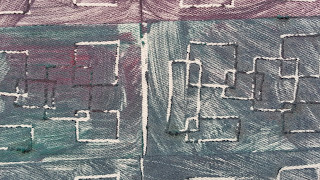The goal is to "explore the possibilities of stamping as a design tool."
Simply cut one lino block a day for 30 days. Or, if you can't wait, cut six in one go for five days. Then print, print, print.
They suggest using rubber erasers. I bought some '
soft lino' which is essentially a rather slim piece of rubber which is indeed very easy to cut into. A pleasure compared to real lino although the deeper you go and the nearer the sides the less sharp is the edge of the cut. Or perhaps that's just my tools.
Here's how it went for me:
 |
| Penciling in a pattern |
 |
| The pattern cut - you can see how the edges 'fray' in this lino; this was happening when I was going over a previous cut with a deeper one - this lino doesn't like it |
 |
| Cutting the lino |
I had some plain acrylic paints and rollers from way back and decided to try out some samples.








































